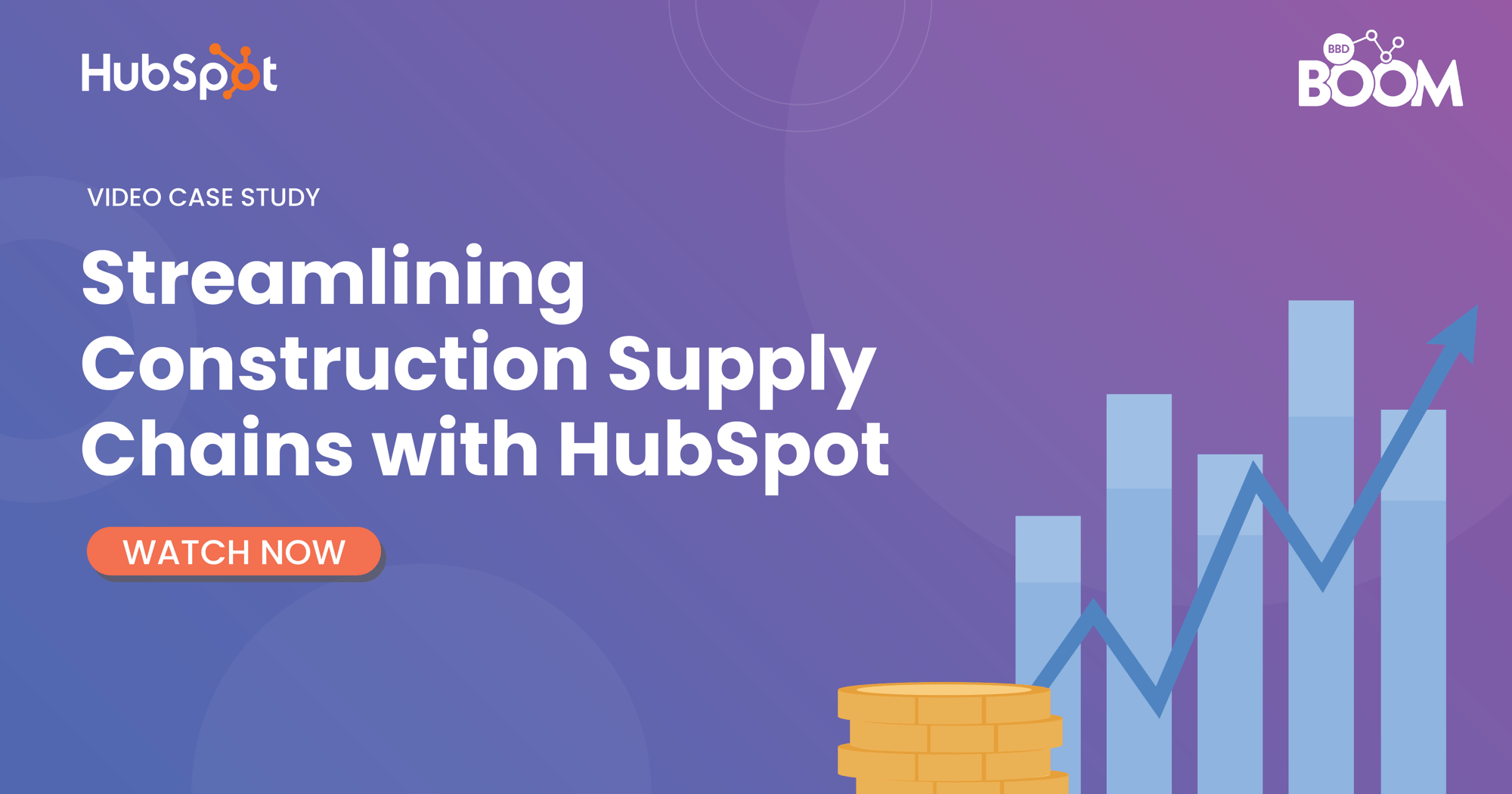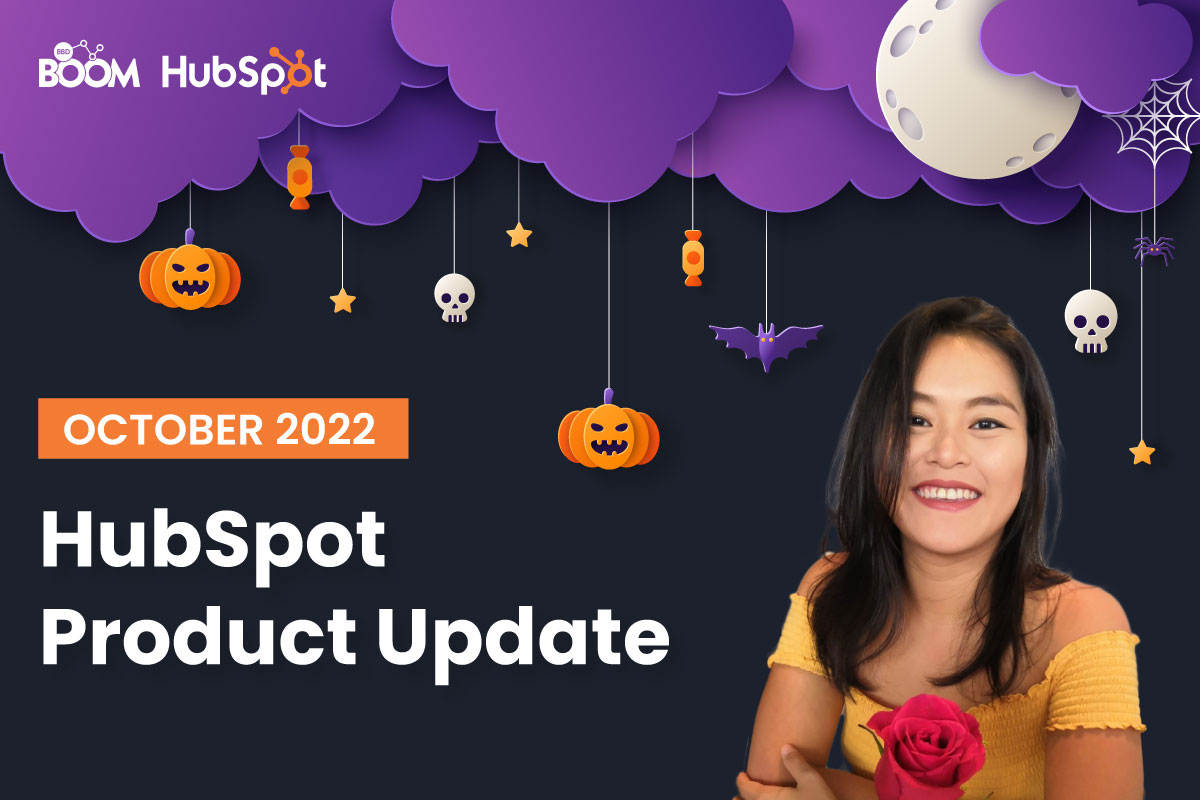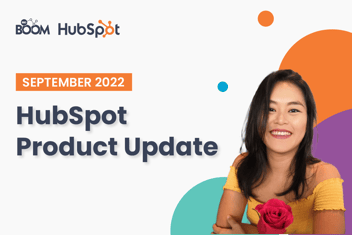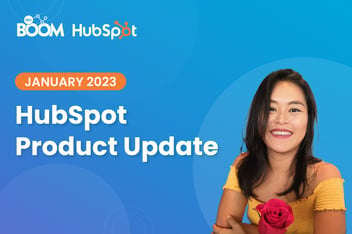Welcome to our HubSpot Product Spotlight for October! In this blog, we’ll explore some of the team's favourite HubSpot updates from the last month. Ready? Let’s dive in!
Now Live
These are all the features now live and ready to use in your HubSpot portal.
Data Join Summary in the Custom Report Builder
What is it?
When selecting the data sources you'd like to report on in the custom report builder, you now have the ability to see an overview of how your data sources are being joined, as well as what records will be included or excluded from your report based on your selection. Additionally, you'll also be able to see a table preview of your selected data sources, which gives you a glimpse into the data you're reporting on.
Why does it matter?
The custom report builder offers you an abundant catalog of your HubSpot CRM objects, assets, and events to report on. When creating a report, you'll often select multiple data sources for your build. Especially when deciding your primary data source—as well as your secondary data sources—it can be difficult to visualize or understand what data you're building from.
Now when selecting your data sources, you have the option to review a data join info tab, which highlights how each of your data sources relate and how many records will be included or excluded from your report. For even greater transparency, you can also preview a data table based on the data sources you've selected.
Before, you would have to go into the editor to see what types of reports you could build based off selected data sources, but now, you'll have the ability to get that insight right from the start. That way, you can ensure you're using the right data, getting you the insights you need even faster.
Recommend playbooks based on deal stage
What is it?
The ability to recommend certain playbooks — those designed to move deals from one stage to the next — based on deal stage. For example, if a specific playbook is designed to help reps move from "Appointment Scheduled" to "Decision Maker Bought In," you can now configure your HubSpot account to recommend that playbook on deals in "Appointment Scheduled."
Why does it matter?
Playbooks are purpose-built sales acceleration tools that are frequently used to move deals forward at specific points in the deal cycle.
It can be difficult for sales reps to find the right playbook to use from a long list of playbooks available to them.
This update will help sales reps discover the right playbook at the right time, to create great experiences for prospects and move deals forward.
Data Quality Command Center
What is it?
A data quality dashboard with in-depth insights for operations teams and admins to monitor and clean potential property issues, record issues, and data-sync health in one, centralized place.
Why does it matter?
With data inputs and updates coming from many sources in a CRM, it can be difficult to monitor and fix potential issues with your records, properties, and integrations. Data quality is the foundation for flywheel teams, and without a “home base” in your CRM to track your data health, you end up solving data problems reactively—only after they’ve become noticeable problems for your teams and customers.
The data quality command center allows for a more proactive approach to data management, giving you an all-in-one dashboard to easily monitor data quality and fix errors before they snowball.
New Apps That Extend the Power of HubSpot CRM & Sales Hub
What is it?
A new collection is live of “built-for-HubSpot” apps that extend the power of the CRM & Sales Hub. These apps are purpose-built by partners in our App Accelerator program and they aim to solve known customer demand gaps that aren't on our roadmap. With both global and regional solutions, these new apps fill gaps in ERP, currency conversion, fundraising, version management, and much more.
Newly available apps include:
- Basket (self-serve eComm for B2B)
- BigCommerce Dynamic Segments (unique, automated custom segmentation)
- Brandgen.io Ad Platform (integrated digital ad platform for B2B)
- Collect (new customer onboarding platform)
- Currency-R8 (dynamically lookup/convert Deal amounts into the currency of your choice)
- Donatio (donation management consolidation
- ERP to HubSpot (data sync between HubSpot & ERPs - even on-prem apps)
- Mercado Libre (integration to the largest digital marketplace in South America)
- NationBuilder (NationBuilder integration)
- NisWire (Telegram integration)
- Purpose Stack (fund climate action as you close Deals)
- SubmitHero (simplify long-form Contact submissions)
- TimeMachine (version control for HubSpot)
Why does it matter?
We realize that there are occasional gaps between our current product capabilities and the full functionality our customers need when they use HubSpot CRM and Sales Hub. That's why we developed an App Accelerator program where we work with our most trusted app partners to efficiently create apps that cover the gaps in our product offering.
Playbook outlines for easier navigation
What is it?
The playbook outline allows users to quickly navigate long playbooks by collecting section headers into a set of clickable anchor links.
Why does it matter?
Users frequently need to skip around sections of a playbook to adapt to the natural flow of conversations with their customers. This can be awkward, time consuming and require a lot of scrolling in long playbooks.
With this update, it's easier to navigate playbooks, so reps can spend less time scrolling and more time connecting.
Personal Export History Now Viewable by all Portal Users
What is it?
Users that have permission to export CRM data from HubSpot can now view their personal export history within import/export settings.
Why does it matter?
Previously, the export audit table within import & export settings was only viewable by super admins on an account. This meant that users who wanted to refer back to an export they completed, or check the status of an export in progress could not do so without the help of a super admin. With this update, we’re making it easier for individual users to manage data in HubSpot, without having to continuously tap an admin on the shoulder for help.
Industry-standard CSAT/NPS questions in custom surveys
What is it?
We are happy to release an exciting update to custom feedback surveys. You can now include industry-standard survey questions such as CSAT and NPS in the custom feedback surveys.
Why does it matter?
Until now, customers were limited to choosing between the industry-standard surveys that had very little customization and the fully customizable feedback surveys that did support industry-standard questions. However, customers want the best of both worlds - the ability to collect industry standard feedback ratings such as CSAT/NPS along with the option to collect additional feedback via custom survey questions. This is exactly what we have introduced via this update to custom surveys.
The standard CSAT/NPS questions in custom surveys are powered by the same underlying feedback properties. So customers can now begin to collect more detailed insights on their customer satisfaction and/or customer loyalty scores, and they can also build reports that include CSAT/NPS scores from the industry-standard surveys and the custom surveys.
Advanced third-party filtering for data sync
What is it?
We have added advanced filtering capabilities to data sync, the native way of syncing HubSpot with your third-party apps. We specifically improved the filtering functionality for inbound data. Now you can much more precisely determine what records can be synced into your HubSpot portal from your third-party app.
Why does it matter?
With this update, we are giving our data sync users more control over the way their data flows in and out of their systems. Previously, if you didn't want to sync all of your records into HubSpot, you could only use one filter. This meant you had to manually check and manage the data inside your third-party app to ensure all the right records matched the single data sync filter.
The new advanced filtering capabilities give you the granularity you require to sync the records you need without any manual back-and-forth – meaning a lot of time and effort saved.
Unread comment indicators
What is it?
The commenting feature inside Email, Forms, Campaigns, Dashboards and more now includes an indicator when there are unread comments.
Why does it matter?
As commenting has become more deeply integrated into HubSpot, it is becoming more and more important to stay on top of the conversation. A recurring issue we’re hearing from you, our customers, is that new comments are easily missed unless they’re tagged directly. To improve the discoverability of these new comments and make this a system you can more confidently rely on for collaboration, you will now see an unread indicator whenever there are new comments, giving you clear feedback about any comments you may otherwise miss.
Using Google Tag Manager and HubSpot’s Cookie Banner together
What is it?
HubSpot offers a direct integration with Google Tag Manager (GTM) that can help you run a GTM script across your HubSpot-hosted pages.
You can also set up a cookie banner through HubSpot. When your HubSpot-hosted pages use the HubSpot cookie banner and GTM integration, third-party cookies placed via GTM won’t be dropped on website visitors’ browsers until they offer consent through the cookie banner.
Why does it matter?
Setting up your HubSpot-hosted pages with GTM via your GTM ID means that you won’t need to take additional steps to manage third-party cookies if your website uses the HubSpot cookie banner.
Earlier this year, HubSpot introduced an update to the GTM integration that offered support for Google’s new Consent Mode. This update meant that third-party cookies dropped by the GTM integration on HubSpot-hosted pages could no longer be managed by the HubSpot cookie banner. This update was reversed on October 12, 2022.
You can now track your Campaign spend
What is it?
We are always working to bring you better reporting capabilities and now, we've implemented a new 'Campaign spend' field to Campaigns, so you can add and track your campaign spend for past, current and future campaigns.
Why does it matter?
We know that it is crucial for you to measure metrics such as your Campaigns ROI, 'cost per [lifecycle]' and more. These metrics take into consideration costs aka spend data of your campaign(s).
Discount Codes
What is it?
Discount Codes can now be created and used on HubSpot Payment Links. Customers can create amount off and percentage off discount codes and manage which payment links discount codes can be used on.
Why does it matter?
Discount codes are an integral part of B2B eCommerce. They will make it easier for companies to sell through HubSpot without having to make unique payment links for each of their offerings. Discount codes can help increase urgency, promote sales, target loyal customers, and generate more revenue.
New API for Account Activity Logs
What is it?
This API exposes both the login and security activity history logs that are currently available to users as an export from within the app.
Why does it matter?
Exposing this same information via a public API will allow portal admins and integrators greater flexibility to use this information in third-party systems and processes.
Limit Login to Trusted IPs
What is it?
This feature allows admins to limit login to their portal to only attempts coming from within their allowed IP range. This allows them to block logins from outside their corporate network, VPN, or allow list of device IPs & restrict any unauthorized access.
Why does it matter?
For security-conscious customers, allowing users to log in from any IP address means they could access HubSpot from unapproved locations like personal computers or public, unsecured wifi networks. This setting allows admins to ensure access is coming from approved locations only, improving security and compliance posture. Further, this allows admins another lever to pull to avoid security incidents .
HubSpot payments timeline activities
What is it?
You can now find HubSpot payments events on a deals, contact and/or a company's activity timeline in the CRM.
Why does it matter?
Previously, payment events were not available on a deal, contact or company in HubSpot. This forced you to navigate to the payments Index page if you needed to see the payments collected from a contact or as part of a deal. This made it difficult to find payment data in the right context in the CRM.
View Permissions for Note Activity
What is it?
Admins can now control visibility of note activity in HubSpot for their users and teams.
Why does it matter?
Granting proper access to CRM data can be challenging. Admins want their teams to be able to interact with CRM records and track their interactions in HubSpot. But some organizations have multiple teams or reps that work from the same records. Seeing other reps' notes could reveal sensitive information or create a competitive conflict on their teams.
With this change, admins can now control which notes their users have access to view. This will ensure relevant prospect and customer data can be saved to HubSpot CRM without compromising sensitive information.
File History
What is it?
When several people work together on a platform it can make it hard to track who has changed what and when. This is why we are introducing File History. With this feature, all users will be able to view what changes have been made to an image, document, or video that lives in your HubSpot Files Tool.
Some of the data tracked includes: who has made a change to the file, when the change was made, what kind of change was it, etc. This is especially helpful when trying to track when a file was deleted, for example. Now users can take the guesswork out of "what happened to my file?".
Why does it matter?
As organizations grow, it can get difficult to keep track of who is doing what. , and we want you to be able to grow with HubSpot seamlessly. By being able to see changes made to your files you can answer questions like:
1. When was this video deleted? Is it still within the recovery period?
2. To which folder was this image moved?
3. Who moved the document I recently uploaded to another folder?
It will help teams have more visibility into each other's work, and add transparency to your Files tool. What's more, now you can check this information quickly right from your portal, without the need to reach out to support!
Introducing a simpler way to get around the HubSpot mobile app on Android
What is it?
A new navigation for the HubSpot mobile app on Android. It’s now easier to access everything you need, wherever you are.
Why does it matter?
The current mobile navigation works great for customers using CRM and Sales tools. This update makes Reporting, Service, and Marketing tools just as easy to find and use.
Delivering a user experience that is crafted, not cobbled, also encouraged us to create a mobile navigation that is more closely aligned to the HubSpot desktop experience, so that our customers can confidently find what they are looking for, regardless of the device they’re on.
New Task Priority Options for Mobile
What is it?
HubSpot mobile users now have more granular options to define their task priorities. You can now use low and medium priority levels in addition to the existing none and high priority levels—just like you can in the desktop experience.
Why does it matter?
Until now, HubSpot mobile users were not able to assign different priority options to a task except for high priority. Without a way to communicate nuances in priority levels, it was challenging for managers to distribute tasks and for teams to plan and organize their time effectively.
Owners will now sync in data sync apps
What is it?
We're adding a new default mapping to several data sync apps to allow keeping record owners in sync. Data sync is the native way of syncing HubSpot with your third-party apps.
Why does it matter?
Several objects in the HubSpot CRM can be assigned to what HubSpot calls an owner. An owner is an actual user of your HubSpot account who acts as the sales representative, customer success manager, or account manager, however, you want to call those users.
Beta
These updates are currently in the works and nearly ready to be released on your HubSpot Portal.
Email notification when SEO Scan completes
What is it?
We will now send an email notification letting you know when your website scan in the SEO tool has finished.
Why does it matter?
There's a small amount of wait time required while our little robots crawl your website and generate your SEO recommendations. Previously, we had no way of letting you know a scan was complete, so you had to go back into the SEO tool to check to see if it was done.
Now, you can move on to other marketing tasks and stay productive while the scan takes place, without switching back and forth to check the status of your scan. We'll send you an email when the scan is done with a link that takes you right back to your recommendations.
Customer Journey Analytics: A new way to report in HubSpot
What is it?
Contacts and customers rarely take the same path on their journey toward a business goal, like filling out a form, talking to sales, or purchasing a product. That's why we're building Customer Journey Analytics, a reporting tool that visually shows the impact of every interaction a contact has with your business.
Customer journey analytics's visual components make it easier than ever to see when, where, and how contacts are moving along their journey with you. By highlighting which touchpoints do and don't work for driving the most conversions, marketers can hone in on where to focus their attention to improve their flywheel.
Why does it matter?
There's no way around it -- every single organization's prospects and customers take a unique path on their journey with a brand. That's why we are creating an incredibly flexible reporting tool that focuses on touchpoints first.
By focusing on the touchpoints (e.g. viewing a landing page, submitting a form, attending a conference, talking to a rep, etc.), you can answer questions like:
- Which landing pages lead to the highest conversion rates on a form?
- Does attending a webinar increase or decrease the likelihood that a prospect will book a meeting with a sales rep?
- Which sequences are the best at converting contacts into customers?
By building for flexibility -- including the ability to include certain lists of contacts in the reports or filtering touchpoints down to specific pages, forms, or campaigns -- we can help marketers report on, understand, and optimize any part of the customer journey.
Re-open WhatsApp threads
What is it?
The ability to re-open an existing WhatsApp thread using a WhatsApp template.
Why does it matter?
WhatsApp only allows businesses to respond to incoming messages for 24 hours, but the reality is, you'll need to be able to send messages outside of the 24 hour period. This is especially important for messages that come in on the weekends and need to be responded to on Monday mornings.
Limit editing access to select pipeline stages
What is it?
Super admin users can now control editing access to deal records in specific pipeline stages. Set the editing access for each pipeline stage to:
- Users with access to deals, or
- Limited to super admins
Once a pipeline stage is set to "Limited to super admins," all deal records entering or already in that "locked" stage will only be editable by super admins. All other users will have read-only access to deal records in that stage (this includes moving a deal record in a "locked" stage into another stage).
This feature is currently only available to Deal objects on Professional and Enterprise plans.
Why does it matter?
Trusting HubSpot with your data means knowing we'll enable you to protect it with safeguards. For sales organizations, Deals data is critical--it determines forecasting, historical reporting, commissions, etc.
With this new ability to limit editing access to select pipeline stages, you can essentially "lock" records in a stage, preventing any further changes to the data. For example, you can limit editing access to the "Closed Won" stage and ensure that only super admins can edit deal records once they enter that stage, or move records out of the "locked" stage.
Sort HubDB data by columns
What is it?
The ability to sort HubDB row data by column within the table editor.

Why does it matter?
When editing data in a spreadsheet-style editor, it can be helpful to sort data based on the cell values of a given column. This can help organize data to manage, view, and edit it more easily.
.png?width=877&height=508&name=bbd-boom-siloy-navy+blue-logo%20(1).png)
.png)

.jpg)












